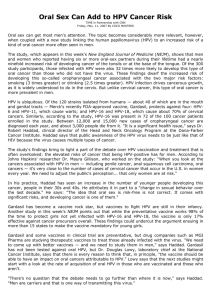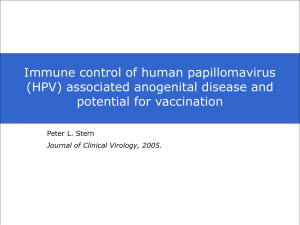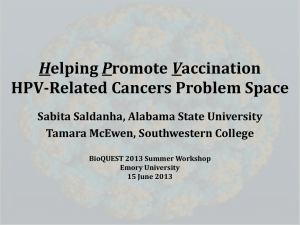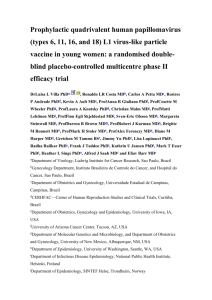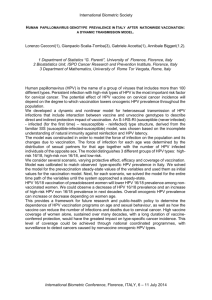Final Report
advertisement
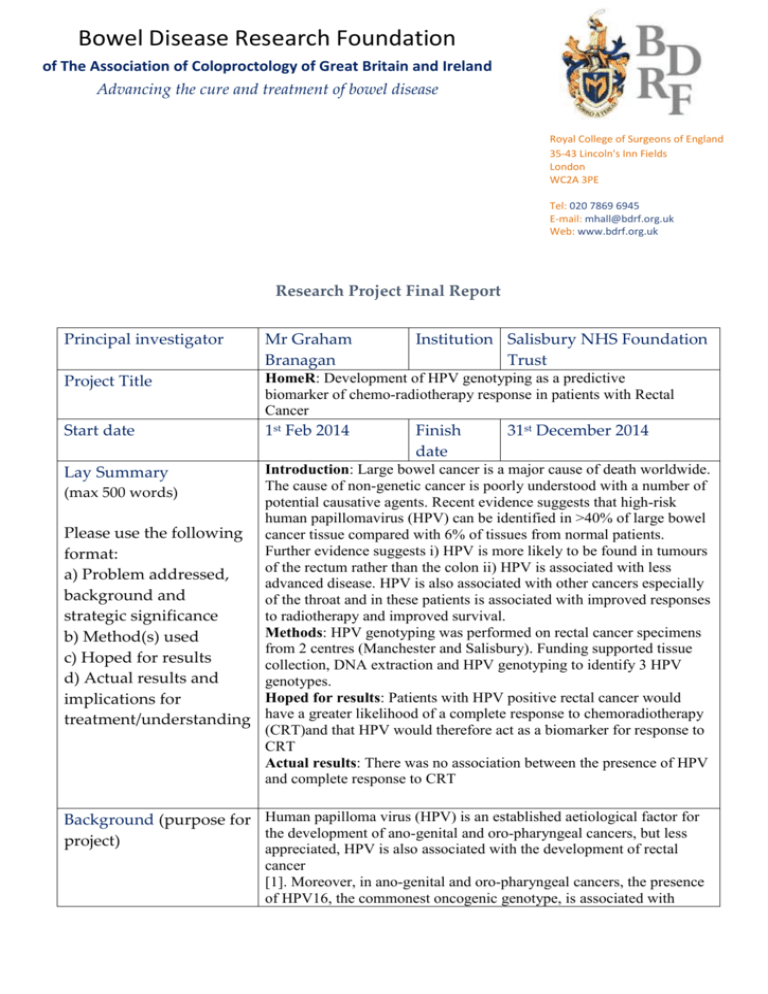
Bowel Disease Research Foundation of The Association of Coloproctology of Great Britain and Ireland Advancing the cure and treatment of bowel disease Royal College of Surgeons of England 35-43 Lincoln's Inn Fields London WC2A 3PE Tel: 020 7869 6945 E-mail: mhall@bdrf.org.uk Web: www.bdrf.org.uk Research Project Final Report Principal investigator Mr Graham Branagan Institution Salisbury NHS Foundation Trust Project Title HomeR: Development of HPV genotyping as a predictive biomarker of chemo-radiotherapy response in patients with Rectal Cancer Start date 1st Feb 2014 Finish date 31st December 2014 Introduction: Large bowel cancer is a major cause of death worldwide. The cause of non-genetic cancer is poorly understood with a number of (max 500 words) potential causative agents. Recent evidence suggests that high-risk human papillomavirus (HPV) can be identified in >40% of large bowel Please use the following cancer tissue compared with 6% of tissues from normal patients. Further evidence suggests i) HPV is more likely to be found in tumours format: of the rectum rather than the colon ii) HPV is associated with less a) Problem addressed, advanced disease. HPV is also associated with other cancers especially background and of the throat and in these patients is associated with improved responses to radiotherapy and improved survival. strategic significance Methods: HPV genotyping was performed on rectal cancer specimens b) Method(s) used from 2 centres (Manchester and Salisbury). Funding supported tissue c) Hoped for results collection, DNA extraction and HPV genotyping to identify 3 HPV d) Actual results and genotypes. Hoped for results: Patients with HPV positive rectal cancer would implications for treatment/understanding have a greater likelihood of a complete response to chemoradiotherapy (CRT)and that HPV would therefore act as a biomarker for response to CRT Actual results: There was no association between the presence of HPV and complete response to CRT Lay Summary Background (purpose for Human papilloma virus (HPV) is an established aetiological factor for the development of ano-genital and oro-pharyngeal cancers, but less project) appreciated, HPV is also associated with the development of rectal cancer [1]. Moreover, in ano-genital and oro-pharyngeal cancers, the presence of HPV16, the commonest oncogenic genotype, is associated with better prognosis and improved response to treatment, mainly chemoradiotherapy (CRT) [2]. A parallel hypothesis has not been tested in rectal cancer. Introduction In the UK, there are approximately 15,000 new cases of rectal cancer per year. Surgery is the mainstay of treatment. Locally advanced disease is treated initially with ‘downstaging’ pre-operative CRT, followed by surgery 8 to 15 weeks later, but this combination is associated with considerable peri-operative mortality and long-term morbidity. In 15% to 20% of cases, CRT may result in complete disappearance of tumour. In patients without residual tumour on imaging and endoscopy (clinical complete response), a waitandsee policy (omission of surgery with follow-up) might be considered an alternative to major resection - and represents a new paradigm for treating rectal cancer - but to-date, there are no predictors for this response, and no recognised adjuvants to enhance this response. The aim of this study was to extend an established HPV genotyping research programme, using highsensitivity assays in anal cancer (Renehan & Hampson, Manchester), to rectal cancer, with the two-fold objectives to: i) Describe the proportions of HPV 16, 18 and 33 in pretreatment rectal cancer specimens, and relations with age, gender and stage (CRUK biomarker classification: BM Discovery Stage 1), and; ii) Test the hypothesis that HPV16 positivity is greater in patients who subsequently develop a complete response compared with those without a complete response to CRT (CRUK biomarker classification: BM Discovery Stage 2). Methods Setting: Salisbury NHS Foundation Trust and the University of Manchester (2006-2013) Patients: Pre-treatment biopsy tissue in patients with rectal adenocarcinoma undergoing CRT. Cases: Patients with rectal cancer who had either a complete clinical or pathological response to CRT were identified from both centre databases. ‘Real-world’ definitions of complete responses i.e. as determined by the MDT were used. Tissue transfer: Whole paraffin-embedded tissue blocks were transferred to Manchester. DNA extraction: DNA was extracted from all the blocks in the NHS BRC Biobank laboratory following GCLP QC standards. QIAamp DNA FFPE tissue kit was used for purification of genomic DNA from formalin-fixed, paraffin-embedded tissues. H&E staining was performed on the slides of the first and last cuts for each sample for pathological examination (to confirm presence of adenocarcinoma). The quality of the DNA was checked using polymerase chain reaction (PCR) to detect the presence of a house-keeping gene (beta-2microglobulin). If the quality of samples was adequate, all the DNA samples underwent whole genome amplification (WGA). The quality of the DNA was checked again using PCR (determination of the presence of beta-2-microglobulin). Bowel Disease Research Foundation of The Association of Coloproctology of Great Britain and Ireland Advancing the cure and treatment of bowel disease Royal College of Surgeons of England 35-43 Lincoln's Inn Fields London WC2A 3PE Tel: 020 7869 6945 E-mail: mhall@bdrf.org.uk Web: www.bdrf.org.uk Laboratory measurements: Multiplex PCR was performed for all HPVs done in this study. Using two sets of primers for each HPV genotype, higher sensitivity / accuracy for HPVgenotyping was performed. Each PCR was be performed with appropriate positive controls as well as with negative control that will be run at the beginning of each PCR and at the end of each PCR to avoid any contamination. Planned statistical analysis: Analyses for objective (i) were standard chi-squared tests (e.g. proportions by gender); Mann-Whitney tests (e.g. median age by HPV positivity); and trends across ordinal categories (e.g. proportions by stage). For objective (ii), we used logistic regression to test differences between complete responders versus others, allowing for adjustment for potential confounders identified in the baseline analysis. Results and discussion Any HPV positivity was noted in 25% of tumours. Individual genotype frequencies were: HPV16, 16%; HPV18, 6%; HPV33, 3%; HPV6, 3%. In multivariate models that included age, gender, pretreatment T-size and N status, there was no association between either any HPV positivity (OR = 1.095, 95% CIs: 0.394, 3.044) or HPV16 positivity (OR = 1.072, 95% CIs: 0.332, 3.465), and complete response to CRT. Conclusion In this stage 2 biomarker discovery study using high-sensitivity HPV multi-valent assays, we found tumour HPV positivity rates lower than those reported elsewhere in the literature. We found no clear ‘signal’ to take forward HPV genotyping for validation as a predictive biomarker for chemo-radiotherapy response in patients with rectal cancer. Recommendations for future work Based on these reults there are no obvious future research avenues for HPV genotyping in rectal cancer and response to radiotherapy References (author, title, date of publication)



